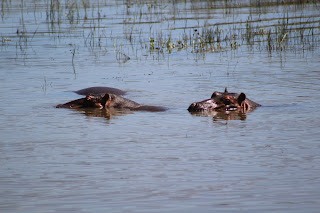We left the
hotel 7 a.m. sharp to begin our journey to Pilanesberg National Park for our
final event of the trip, a safari. When we arrived at the park we jumped into a
canvas covered truck. Pilanesberg is home to all five of the big five of
Africa; the African leopard, African elephant, African lion, Cape Buffalo, and
rhinoceros. They are referred to the big five as they are the most difficult
animals to hunt in Africa. The park is 55,000 hectares (approximately 22,000
acres) and was established in 1979.
The first wild animal spotted was a
pod of hippos. They were very bashful and would only stick their nostrils out
of the water. However, in real life, hippos are very aggressive and are more
dangerous than the wild cats. Hippos are also scavengers and will steal kills
from predators.
Next, we saw a tower of giraffes,
boy were they tall! Our guide shared with us that giraffes have the same number
of vertebrae in their neck as humans.
Out of pure luck, we came across a
couple rhinoceroses hiding in the distance. Our guides stated that seven rhinos
had been poached on the park within the last year, and due to poaching they are
close to extinction. People poach the rhino for their horns. To prevent
poaching, some parks in Africa remove the horn of the rhino. However, since
this horn is their means of protection, they will not survive without it. There
are two types of rhinos in Africa, the black rhino and white rhino. According to our guide, the black rhino’s
calf will follow the mother, much like a black mother in South Africa carries her baby on her
back. The white rhino’s calf will travel in front of the mother, much like a
white woman pushing her baby in a stroller. We also saw warthogs, wildebeests,
zebras, Springbok, birds, Impala, Greater Kudu, and Eland.
The highlight of the safari was
following one of the 500 elephants in the park. We first saw the male elephant
far away in the bush. We then saw him later throughout the day lurking 100 feet
from the truck. After a quick pit stop, we got a CB radio call that an elephant
was on the road. The call went a little bit like “copy-copy bushman one, this
is bushman two we got a big ol’ elephant located over here by the northwest
watering hole, make sure Toto blesses the rains on the way over. Over and out.”
But for real, we sped over to that elephant and had a once in a lifetime encounter. The male elephant had found a small watering hole and was cooling himself down. He was having quite a fun time being admired by all the tourists. He then proceeded to walk a foot from our truck and travel down the road. Many of the students, such as Gabby, had priceless faces that summed up everyone’s thoughts on the safari. A neat fact about the elephants, is their ears are shaped like the continent of Africa.
This trip impacted many students’ lives. Whether it was growing a greater appreciation for the advancements of agriculture in the U.S. or a moral government, this trip was nothing less than ‘ongelooflike’ (amazing in Afrikaans).
‘Baie dankie’ Africa! (Written by Kiera and Sam)
We had lots of fun taking photos, and Dr. Gonda can attest that we probably had too much fun. Here is a collection of some of our favorites from today!
Giraffe towering above the landscape.
Elephant fanning its African continent shaped ears.
Gabby expressing her love for elephants!
Kiera and Sam taking a selfie with the wildebeest and zebra.
Dr. Sharon Clay representing the Jackrabbits.
Hungry, hungry hippos chilling like villains in the local watering hole.






No comments:
Post a Comment